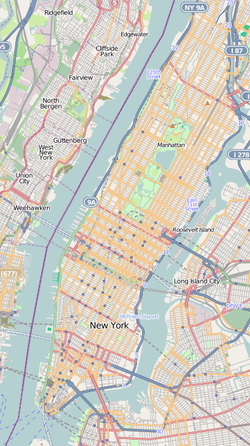
Back سوهو (نيويورك) Arabic سوهو، مانهاتان AZB Сохо (Манхатън) Bulgarian SoHo (Manhattan) Catalan SoHo Danish SoHo (Manhattan) German Σόχο Greek SoHo (Nueva York) Spanish SoHo Estonian SoHo (New York) Basque
SoHo | |
|---|---|
 | |
 Location in New York City | |
| Coordinates: 40°43′23″N 74°00′00″W / 40.723°N 74.000°W | |
| Country | |
| State | |
| City | New York City |
| Borough | Manhattan |
| Community District | Manhattan 2[1] |
| Named for | "South of Houston Street" |
| Area | |
• Total | 0.87 km2 (0.336 sq mi) |
| Population (2019)[2] | |
• Total | 18,894 |
| • Density | 22,000/km2 (56,000/sq mi) |
| Economics | |
| • Median income | $135,083 |
| Time zone | UTC−5 (Eastern) |
| • Summer (DST) | UTC−4 (EDT) |
| ZIP codes | 10012, 10013 |
| Area code | 212, 332, 646, and 917 |
SoHo–Cast Iron Historic District | |
| Location | Roughly north to south: Houston to Canal Streets; and west to east: West Broadway or Sixth Avenue to Crosby Street or Lafayette Street Manhattan, New York City |
| Coordinates | 40°43′23″N 74°00′00″W / 40.723°N 74.000°W |
| Area | 73 acres (30 ha) |
| Architectural style | Renaissance Italianate some Federal |
| NRHP reference No. | 78001883[3] |
| Significant dates | |
| Added to NRHP | June 29, 1978 |
| Designated NYCL | August 14, 1973 May 11, 2010 (extension) |
SoHo, short for "South of Houston Street",[4] is a neighborhood in Lower Manhattan, New York City. Since the 1970s, the neighborhood has been the location of many artists' lofts and art galleries, and has also been known for its variety of shops ranging from trendy upscale boutiques to national and international chain store locations. The area's history is an archetypal example of inner-city regeneration and gentrification, encompassing socioeconomic, cultural, political, and architectural developments.[5]
The name "SoHo" derives from the area being "South of Houston Street", and was coined in 1962 by Chester Rapkin,[6] an urban planner and author of The South Houston Industrial Area study,[7] also known as the "Rapkin Report".[notes 1] The name also recalls Soho, an area in London's West End.[8]
Almost all of SoHo is included in the SoHo–Cast Iron Historic District, which was designated by the New York City Landmarks Preservation Commission in 1973, extended in 2010, and was listed on the National Register of Historic Places and declared a National Historic Landmark in 1978.[9] It consists of 26 blocks and approximately 500 buildings,[10] many of them incorporating cast-iron architectural elements. Many side streets in the district are paved with Belgian blocks.[11]
SoHo is part of Manhattan Community District 2 and its primary ZIP Codes are 10012 and 10013.[1] It is patrolled by the 1st and 5th Precincts of the New York City Police Department.
- ^ a b "NYC Planning | Community Profiles". communityprofiles.planning.nyc.gov. New York City Department of City Planning. Retrieved March 18, 2019.
- ^ a b c "Soho neighborhood in New York". Retrieved March 18, 2019.
- ^ "National Register Information System". National Register of Historic Places. National Park Service. March 13, 2009.
- ^ As in, for example, "Soho, New York, guide: The best of the neighborhood". Time Out New York. Retrieved December 27, 2013. Sweeney, Sean (October 17, 2013). "Secret vote on the Soho BID was some tricky business". The Villager. Greenwich Village, New York City. Retrieved December 27, 2013. Strickland, Julie (October 18, 2013). "Soho BID gets green light amid community opposition". New York City: TheRealDeal.com. Retrieved December 27, 2013.
- ^ SoHo, New York – Mixed Use, Density and the Power of Myth Archived July 8, 2008, at the Wayback Machine Barr, Alistair – Architect
- ^ Hevesi, Dennis. "Obituary: Chester Rapkin, 82, Urban Planning Theorist" The New York Times (February 3, 2001)
- ^ Rapkin, Chester. The South Houston Industrial Area (Prepared for the City of New York, City Planning Commission, Department of City Planning, 1963)
- ^ White, Norval; Willensky, Elliot; Leadon, Fran (2010). AIA Guide to New York City (5th ed.). New York: Oxford University Press. p. 111. ISBN 978-0-19538-386-7.
- ^ Soho Cast-Iron Historic District Archived June 5, 2011, at the Wayback Machine, National Park Service, n.d. Accessed March 26, 2011.
- ^ Karen Graham Wade; Marjorie Pearson; James T. Dillon; et al. (n.d.). "National Register of Historic Places Inventory-Nomination: SoHo–Cast Iron Historic District" (pdf). National Park Service. and Accompanying photos, various dates (6.49 MB)
- ^ Koppel, Niko. "Restoring New York Streets to Their Bumpier Pasts" The New York Times (July 18, 2010)
Cite error: There are <ref group=notes> tags on this page, but the references will not show without a {{reflist|group=notes}} template (see the help page).

